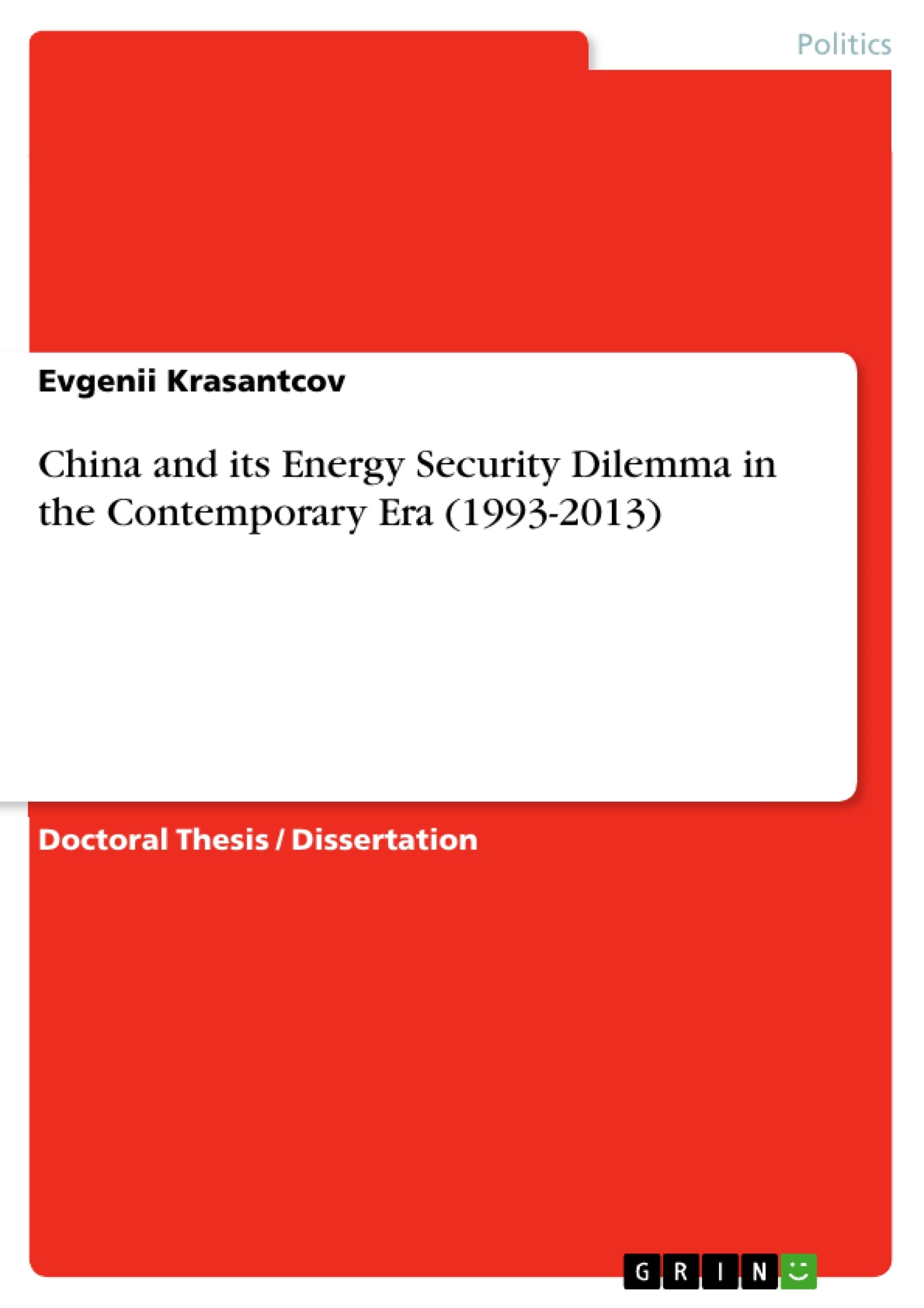This research covers the topic of energy security in China in the period of 1993 to 2013. The first chapter starts from a general understanding of the “energy security” notion and different approaches on its preservation. Then, it follows to the evolution of the term in China proceeding to the part describing the common situation with the most energy consuming states in the Asia-Pacific Region. The second chapter analyzes different approaches on handling energy security dilemma in China within its domestic policy. The scrutiny is made to follow the path from a widely applied over the history of China - extensive approach, continuing with a less popular but still valuable - intensive approach, and finishing with the most promising – innovative approach. Ultimately the third chapter goes beyond the internal boundaries and shows possible solutions to the risen problem on the global scale. It refers to enlargement of Beijing’s foreign energy partnership and unraveling the tangle of the Malacca Strait by an extra pipeline system crossing Myanmar, canal projects traversing some South-East Asia states, expanded energy resources production in the South China Sea and partial redirection of Chinese petroleum and LNG carriers northwards.
Inhaltsverzeichnis
- Introduction
- Energy security in the APR countries: history, theory, exercise
- Evolution of the "energy security" notion
- The history of the PRC. From energy policy to security
- security and its practical threats. The case of the Asia-Pacific regmon
- Various ways to ensure energy security within the framework of Chinese domestic policy
- Extensive approach in energy security. History and perspectives
- Intensive approach. The leading course or a transitional stage
- Innovative approach. The forthcoming future of security
- Chinese foreign policy for the good of energy security
- International cooperation as the means of sustainable energy security in China
- Energy value of the Strait of Malacca and the South China Sea. Perspectives and threats
- The northern stream. An alternative solution to the dilemma of a safe sea enerw route
- Conclusion
- References
- Appendix
- List of abbreviations
Zielsetzung und Themenschwerpunkte
Diese Arbeit analysiert die Herausforderungen der Energiesicherheit in China im Zeitraum von 1993 bis 2013. Sie konzentriert sich auf die Entwicklung der chinesischen Energiepolitik, die sich von einer Politik der Selbstversorgung hin zu einer Strategie der Diversifizierung und internationalen Zusammenarbeit entwickelt hat. Die Arbeit beleuchtet die verschiedenen Ansätze zur Sicherung der Energiesicherheit, einschließlich der extensiven, intensiven und innovativen Ansätze, und untersucht die damit verbundenen Herausforderungen und Chancen. Darüber hinaus werden die wichtigsten Energiequellen Chinas, wie Kohle, Öl, Erdgas und erneuerbare Energien, analysiert, sowie die Rolle der internationalen Zusammenarbeit bei der Sicherung der Energiesicherheit.
- Entwicklung der chinesischen Energiepolitik von Selbstversorgung zu Diversifizierung und internationaler Zusammenarbeit
- Die Rolle der extensiven, intensiven und innovativen Ansätze zur Sicherung der Energiesicherheit
- Die Herausforderungen und Chancen der verschiedenen Energiequellen Chinas
- Die Bedeutung der internationalen Zusammenarbeit für die Energiesicherheit Chinas
- Die Rolle der geopolitischen Faktoren in der Energiesicherheit Chinas
Zusammenfassung der Kapitel
Die Einleitung stellt die Bedeutung der Energiesicherheit im Kontext der globalen Wirtschafts- und politischen Entwicklung dar. Sie beleuchtet die Herausforderungen, denen China im Hinblick auf seine Energiesicherheit gegenübersteht, insbesondere die rasche Zunahme des Energiebedarfs und die begrenzten heimischen Ressourcen.
Kapitel 1 untersucht den Begriff der Energiesicherheit und seine historische Entwicklung. Es analysiert die verschiedenen Definitionen des Begriffs, die in der westlichen, russischen und chinesischen Literatur verwendet werden, und identifiziert die wichtigsten Bedrohungen für die Energiesicherheit. Es wird auch auf die Entwicklung der chinesischen Energiepolitik von der Gründung der Volksrepublik China bis zum Beginn des 21. Jahrhunderts eingegangen.
Kapitel 2 analysiert die verschiedenen Ansätze zur Sicherung der Energiesicherheit in China. Es werden die extensive, intensive und innovative Ansätze untersucht, ihre Vor- und Nachteile sowie ihre Anwendung in der Praxis. Das Kapitel beleuchtet die Herausforderungen und Chancen, die mit der Nutzung von Kohle, Öl, Erdgas und erneuerbaren Energien verbunden sind.
Kapitel 3 befasst sich mit der chinesischen Außenpolitik im Hinblick auf die Energiesicherheit. Es werden die wichtigsten internationalen Energiepartnerschaften Chinas, insbesondere mit Russland und den zentralasiatischen Staaten, untersucht. Das Kapitel beleuchtet die Bedeutung der Diversifizierung der Energiequellen und -routen, insbesondere im Hinblick auf die Abhängigkeit von der Straße von Malakka. Darüber hinaus wird die Bedeutung des Südchinesischen Meeres und der Arktis für die Energiesicherheit Chinas analysiert.
Schlüsselwörter
Die Schlüsselwörter und Schwerpunktthemen des Textes umfassen die Energiesicherheit, die chinesische Energiepolitik, die Diversifizierung der Energiequellen und -routen, die internationalen Energiepartnerschaften Chinas, die Straße von Malakka, das Südchinesische Meer, die Arktis, die extensiven, intensiven und innovativen Ansätze zur Sicherung der Energiesicherheit, Kohle, Öl, Erdgas, erneuerbare Energien, geopolitische Faktoren, die Herausforderungen und Chancen der Energiesicherheit Chinas.
- Citation du texte
- Evgenii Krasantcov (Auteur), 2014, China and its Energy Security Dilemma in the Contemporary Era (1993-2013), Munich, GRIN Verlag, https://www.grin.com/document/275170



